Ayant géré des dizaines de sites WordPress au fil des ans, nous avons nous-mêmes eu affaire à un nombre incalculable de commentaires indésirables. L’une de nos techniques les plus efficaces pour lutter contre les indésirables consiste à retirer le champ de l’URL du site des formulaires de commentaires.
Bien que les extensions de spam de commentaires aident, de nombreux spammeurs continuent d’ajouter manuellement des liens promotionnels via le champ d’URL du site dans votre formulaire de commentaire. En retirant ce champ d’URL, vous pouvez réduire considérablement les tentatives d’indésirables tout en gardant votre section de commentaires ouverte.
Dans cet article, nous allons vous afficher plusieurs façons de retirer le champ de l’URL du site de votre formulaire de commentaire WordPress, des solutions simples d’extension à une méthode de code facile.
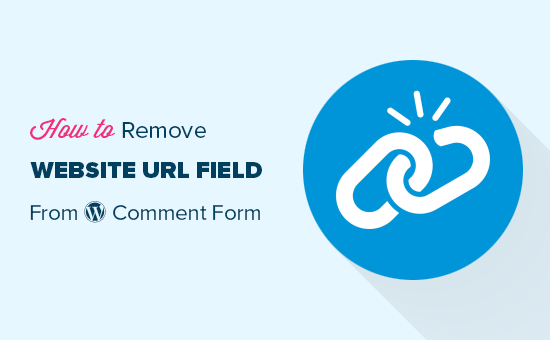
Pourquoi les gens envoient-ils des commentaires indésirables ?
Étant donné que la plupart des indésirables sont générés par des robots automatisés, vous pouvez facilement lutter contre le spam de commentaires à l’aide d’outils et d’extensions gratuits. Cependant, il est beaucoup plus difficile d’arrêter les commentaires indésirables qui sont envoyés par des personnes.
Ces Sujet sont souvent inactif, hors sujet et n’apportent aucune valeur ajoutée à la conversation.
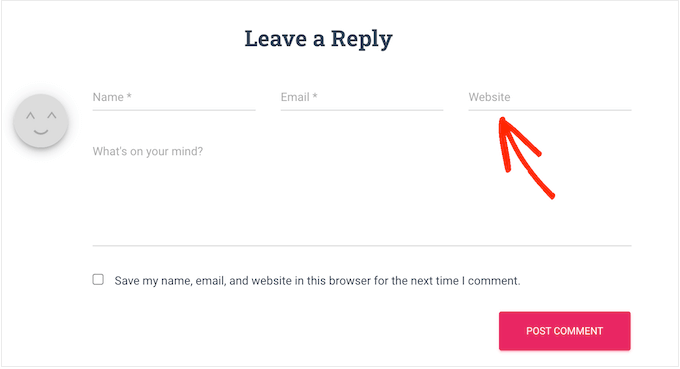
Lorsqu’il affiche les commentaires, WordPress lie automatiquement l’identifiant de la personne à l’URL du site qu’elle a fournie. Les spammeurs peuvent utiliser ce champ pour obtenir des backlinks ou pour essayer d’obtenir un meilleur classement pour des mots-clés spécifiques.
En retirant le champ de l’URL du site web, vous pouvez décourager les spammeurs de publier sur votre blog ou site WordPress. Et comme vous pouvez le voir dans notre formulaire de commentaire WPBeginner, nous avons désactivé cette fonctionnalité exacte comme ça :

Nous procédons ainsi car nous pensons que les utilisateurs/utilisatrices authentiques laisseront un commentaire, qu’ils obtiennent ou non un lien retour. Cela ne devrait donc pas avoir d’incidence sur le nombre de commentaires de qualité que vous obtenez.
Cela étant dit, jetons un coup d’œil à 3 méthodes différentes pour retirer le champ site web du formulaire de commentaire de votre site WordPress. Vous pouvez utiliser les liens rapides ci-dessous pour passer directement à la méthode que vous souhaitez utiliser :
Méthode 1 : Retirer le champ de l’URL du site avec Thrive Comments (Recommandé)
La première méthode utilise Thrive Comments, la meilleure extension de commentaires pour WordPress.
En plus d’empêcher les utilisateurs/utilisatrices d’insérer des URL spammy, vous pouvez également utiliser l’extension pour stimuler l’engagement de vos commentaires. Par exemple, vous pouvez autoriser les utilisateurs/utilisatrices à aimer et à ne pas aimer les commentaires et même rediriger les commentateurs vers une publication pertinente pour augmenter vos pages vues.
En savoir plus, consultez notre avis complet sur Thrive Themes, où nous parlons plus en détail de Thrive Comments.
Tout d’abord, rendez-vous sur le site de Thrive Themes pour créer un nouveau compte et obtenir une offre payante.

Une fois inscrit, il suffit de se rendre sur le Tableau de bord du compte.
Ici, cliquez sur le lien ” Télécharger et installer l’extension Thrive Product Manager “.
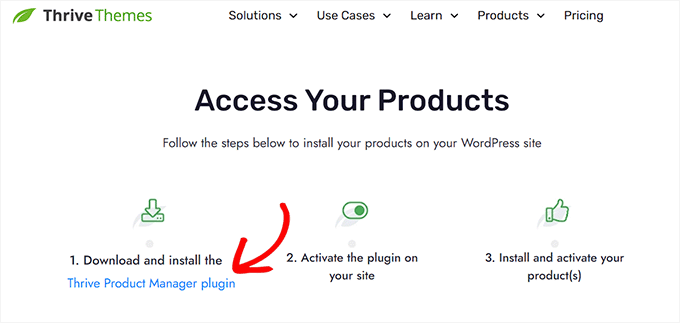
À ce stade, vous pouvez installer l’extension Thrive Product Manager sur votre site WordPress. Pour plus de détails, veuillez consulter notre guide sur l ‘installation d’une extension WordPress.
Maintenant, allez sur la page Gestionnaire de produits depuis votre zone d’administration WordPress et cliquez sur le bouton ” Se connecter à mon compte “.

Vous devriez maintenant voir le tableau de bord du gestionnaire de produits Thrive.
Ici, il suffit de sélectionner Thrive Comments et de cliquer sur le bouton ” Installer les produits sélectionnés “.
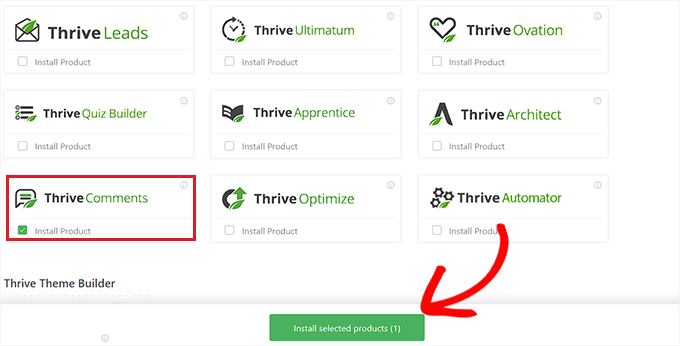
Un message de réussite indiquant “Prêt à l’emploi” devrait apparaître une fois l’installation terminée.
Maintenant, il suffit de cliquer sur le bouton ” Aller au Tableau de bord des thèmes Thrive ” en bas.
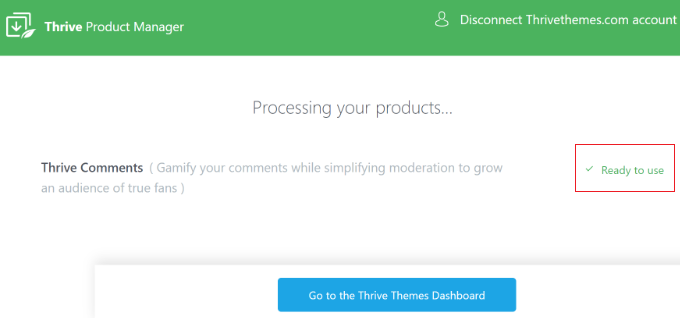
Sur la page suivante, vous verrez toutes vos extensions installées dans la suite.
Cliquez sur le bouton ” Thrive Comments ” pour commencer à utiliser l’extension.
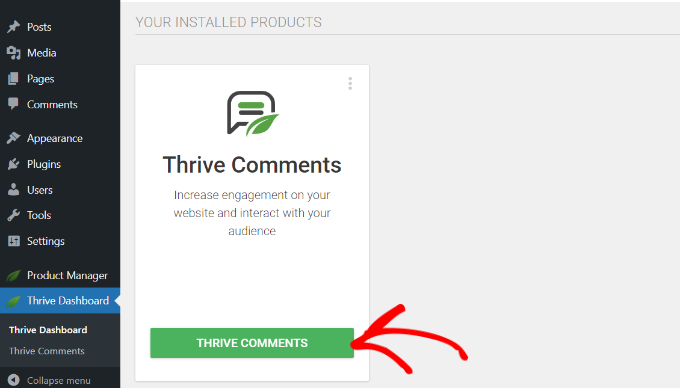
Sur la page Thrive Comments, ouvrez le menu “Connexion aux commentaires”.
Désactivez ensuite le réglage “Permettre aux invités d’insérer l’URL de leur site”.
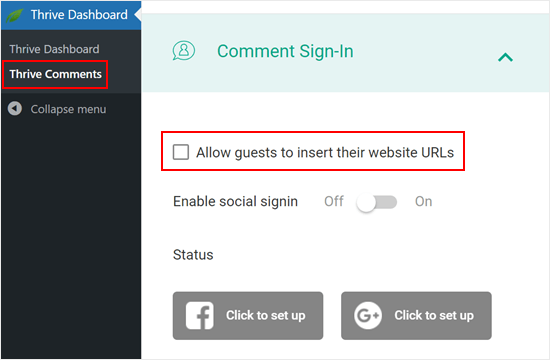
Cette option retire le champ URL du site de votre site WordPress.
Ainsi, votre section de commentaires restera exempte d’indésirable et vos commentateurs authentiques ne cliqueront pas accidentellement sur des liens malveillants.
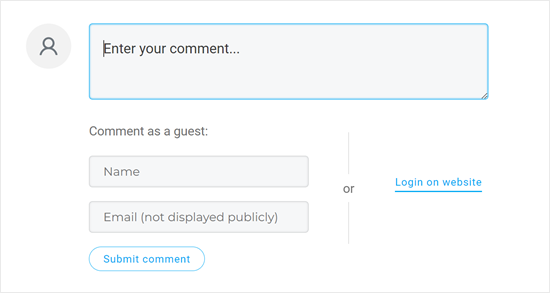
C’est tout. Si vous souhaitez utiliser Thrive Comments pour améliorer votre section de commentaires, voici d’autres guides que vous pouvez consulter :
- Comment mettre en avant ou enterrer des commentaires dans WordPress
- Comment permettre à vos utilisateurs/utilisatrices de s’abonner aux commentaires dans WordPress ?
- Comment permettre aux utilisateurs/utilisatrices d’un blog de modérer les commentaires sur WordPress ?
Méthode 2 : Retirer le champ de l’URL du site à l’aide d’une extension gratuite
Si vous souhaitez retirer le champ URL de votre formulaire de commentaire WordPress à l’aide d’une extension gratuite, consultez Comment Link Retirer et Comment Tools.
Cette extension vous permet de retirer le champ et de supprimer également tous les liens des commentaires que vous avez déjà approuvés.
Tout d’abord, vous devez installer et activer le plugin Comment Link Retirer et Comment Tools. Pour des instructions détaillées, consultez notre guide sur l’installation d’une extension WordPress.
Une fois activé, cliquez sur Outils de commentaires “ Outils de commentaires dans le tableau de bord WordPress.
Cochez la case située à côté de “Retirer le champ WEBSITE du formulaire de commentaire”. Cela découragera les spammeurs d’insérer leurs liens.
Cela dit, tous les commentaires que vous avez précédemment approuvés contiendront toujours un Link. Pour retirer ces URL, il vous suffit de cocher la case située à côté de “Retirer le lien hypertexte de la bio de l’auteur du commentaire”.
Nous vous recommandons également d’inactif le réglage “Désactiver la transformation des URL en liens hypertextes dans les commentaires”. Cette option empêche l’affichage des URL dans les commentaires sous forme d’hyperliens cliquables.
Par ailleurs, vous pouvez facultativement activer l’option “Retirer les identifiants HTML Link dans les commentaires”. Ce réglage retire les identifications HTML qui créent des liens hypertextes dans les commentaires. Cela permet de s’assurer que les URL ou les liens contenus dans les commentaires ne s’affichent pas comme des liens cliquables.
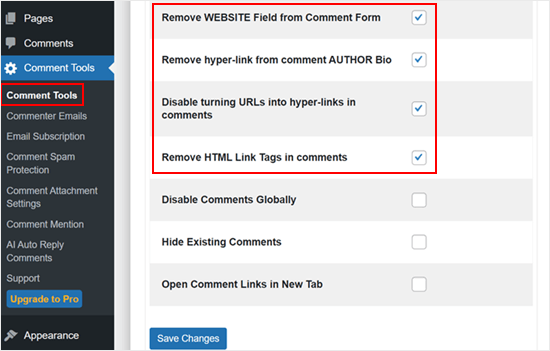
Une fois cela fait, défilez jusqu’au bas de la page et cliquez sur le bouton “Enregistrer les modifications” pour stocker vos réglages.
Pour voir cette modification en action, vous pouvez soit vous déconnecter de votre compte, soit visiter votre site dans un onglet incognito.
Vous constaterez que le formulaire de commentaire ne comporte plus de champ pour l’URL du site.
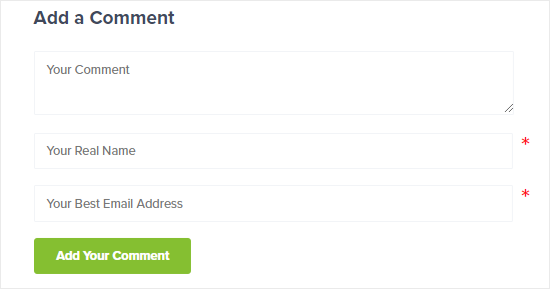
En outre, les noms des auteurs/autrices des commentaires qui comportaient des liens n’en auront plus, et les utilisateurs/utilisatrices ne pourront plus cliquer dessus.
L’un des signes révélateurs est que la couleur du texte du nom de l’auteur/autrice du commentaire qui avait des liens sera la même que celle qui n’en a pas.

Méthode 3 : Retirer le champ de l’URL du site à l’aide d’un code
Une autre option consiste à retirer le champ du site web du formulaire de commentaire de WordPress à l’aide d’un extrait de code.
La raison pour laquelle nous voulons vous afficher cette méthode est que, bien que l’extension puisse supprimer le champ URL, elle conserve la case à cocher “Gagner mon nom, mon e-mail et mon site dans ce navigateur pour la prochaine fois que je commenterai” en bas de page.
Pour garder les choses cohérentes, nous voulons modifier ce texte en “Gagner mon nom et mon e-mail dans ce navigateur pour la prochaine fois que je commente.” Et nous pouvons le faire en utilisant du code personnalisé.
Souvent, les tutoriels vous diront d’ajouter des extraits de code personnalisés au fichier functions.php de votre thème.
Cependant, nous ne recommandons pas cette approche car même une petite erreur dans votre code pourrait provoquer un certain nombre d’erreurs WordPress courantes ou même casser complètement votre site. Cette approche nécessite également la création d’un thème enfant afin que votre thème parent ne soit pas affecté.
Au lieu de faire tout cela, nous vous recommandons d’utiliser WPCode. C’est le moyen le plus simple et le plus sûr d’ajouter du code personnalisé dans WordPress sans avoir à modifier les fichiers du cœur du thème.
Note : Bien qu’il existe une extension WPCode gratuite, nous utiliserons la version premium pour ce tutoriel.
La première chose à faire est d’installer et d’activer l’extension WPCode sur votre site. Pour plus de détails, consultez notre guide étape par étape sur l’installation d’une extension WordPress.
Ajout d’un code pour Retirer le champ URL du formulaire de commentaire WordPress
Une fois activé, allez dans Extraits de code ” Ajouter un extrait.
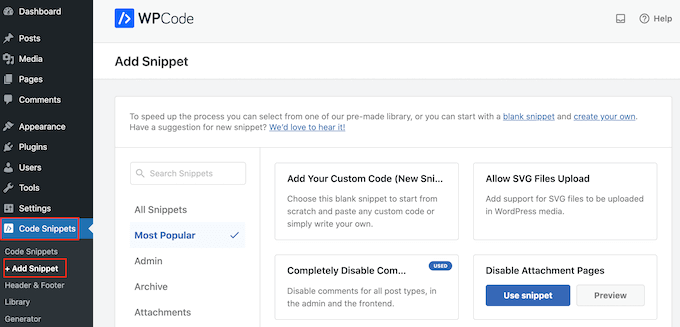
Ensuite, naviguez jusqu’à l’onglet “Commentaires” et trouvez l’extrait “Désactiver l’URL du site du formulaire de commentaire”.
Si vous ne vous êtes pas encore connecté à la Bibliothèque WPCode, cliquez sur le bouton “Se connecter à la bibliothèque pour déverrouiller (gratuit)”.
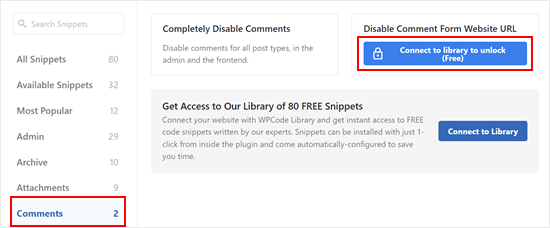
À ce stade, il vous suffit de vous connecter à votre compte WPCode.
Retournez ensuite à la page précédente de l’extension WPCode. Vous verrez maintenant que le bouton a été modifié en “Utiliser l’extrait”. Cliquez dessus pour l’utiliser.
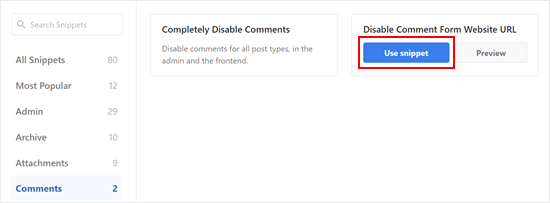
Vous verrez maintenant l’écran de l’éditeur d’extraits de code avec le code permettant de retirer le champ de l’URL du site du formulaire de commentaire.
Il ne vous reste plus qu’à cliquer sur le permuter “Inactif” pour qu’il affiche “Actif”. Cliquez ensuite sur “Mettre à jour” pour rendre cet extrait direct.
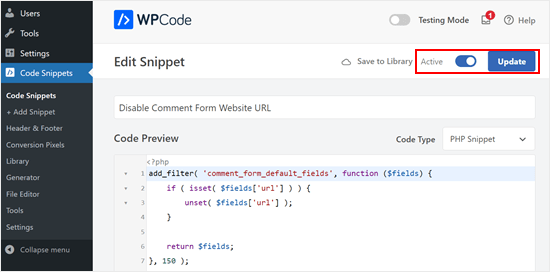
Aucun internaute ne peut désormais ajouter l’URL d’un site à ses commentaires.
Ajout d’un code pour Retirer les liens existants dans les auteurs/autrices des commentaires
Le code de l’étape précédente retire uniquement le champ de l’URL du site des formulaires de commentaires, mais les commentaires existants avec des noms d’auteurs/autrices liés auront uniquement des liens.
Heureusement, vous pouvez aussi les Retirer facilement avec WPCode. Pour ce faire, il vous suffit de retourner dans la rubrique Extraits de code ” Ajouter un extrait. Cliquez ensuite sur “Utiliser l’extrait” sous “Ajouter votre code personnalisé (nouvel extrait)”.
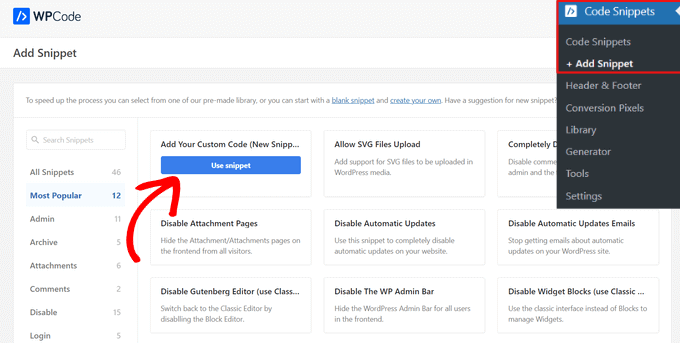
Vous pouvez maintenant donner un nom à cet extrait de code pour qu’il soit facilement identifiable. Il peut s’agir de quelque chose de simple comme “Retirer les liens hypertextes dans le nom de l’auteur/autrice du commentaire”.
Ensuite, modifiez le type de code en “Extrait de PHP”.
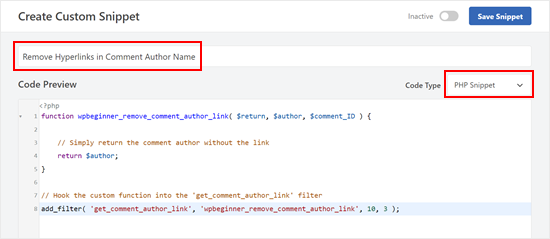
Une fois cela fait, copiez et collez l’extrait de code suivant dans la boîte de Prévisualisation du code :
1 2 3 4 5 6 7 8 | function wpbeginner_remove_comment_author_link( $return, $author, $comment_ID ) { // Simply return the comment author without the link return $author;}// Hook the custom function into the 'get_comment_author_link' filteradd_filter( 'get_comment_author_link', 'wpbeginner_remove_comment_author_link', 10, 3 ); |
En défilant vers le bas, assurez-vous que la méthode d’insertion est “Insertion automatique” et que l’Emplacement est “Exécuter partout”.
Il suffit ensuite d’activer le code et de cliquer sur “Enregistrer l’extrait”.
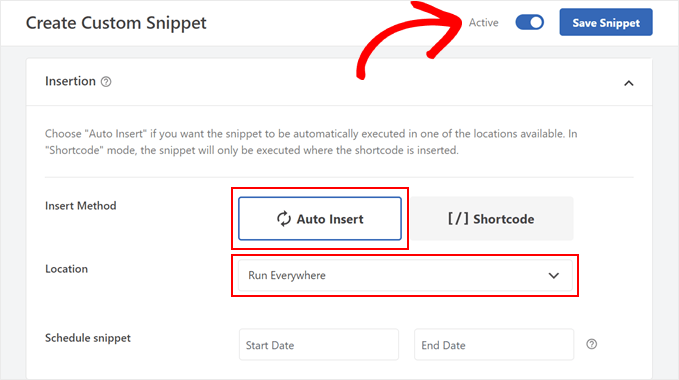
Aucun lien n’apparaît désormais dans les anciens noms d’auteurs/autrices de commentaires.
Ajout d’un code pour remplacer le texte de lacase à cocher “Cookies Opt-In” des commentaires
Si vous choisissez d’afficher la case à cocher d’acceptation des cookies de commentaires dans votre formulaire de commentaires, alors vous verrez très probablement ce texte de case à cocher : “Gagner du du nom, de l’e-mail et du site dans ce navigateur pour la prochaine fois que je commente”.
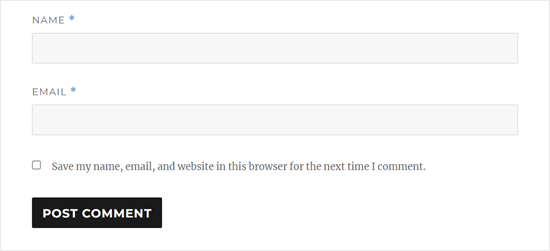
L’apparence de cette case à cocher lorsque vous n’aurez plus le champ de l’URL du site sera assez gênante. C’est donc une bonne idée de remplacer ce texte.
Pour ce faire, il suffit de créer un nouvel extrait de code comme dans l’étape précédente et de définir le type de code comme “PHP Snippet”. Vous pouvez nommer ce code “Remplacer les commentaires par le texte de la case à cocher Cookie”.
Ensuite, copiez et collez l’extrait de code ci-dessous dans la boîte de Prévisualisation du code :
1 2 3 4 5 6 7 8 9 10 11 12 13 14 | // Hook a custom function 'remove_website_from_checkbox_text' into the 'gettext' filteradd_filter('gettext', 'remove_website_from_checkbox_text');function remove_website_from_checkbox_text($translated_text) { // Replace the original text with the modified text $translated_text = str_replace( 'Save my name, email, and website', // Original text to find 'Save my name and email', // Replacement text $translated_text // The text being processed ); // Return the modified translated text return $translated_text;} |
Vous pouvez définir les Réglages de la Méthode d’insertion et de l’Emplacement comme auparavant.
Une fois que vous avez fait cela, il suffit de rendre le code activé et de cliquer sur ” Enregistrer l’extrait “.
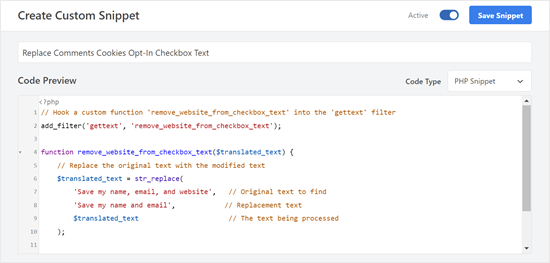
Si le code est réussi, vous devriez voir le texte de l’opt-in modifié en “Gagner mon nom et mon e-mail dans ce navigateur pour la prochaine fois que je commente.”
Voici à quoi ressemble le texte de l’accord sur notre site de test :
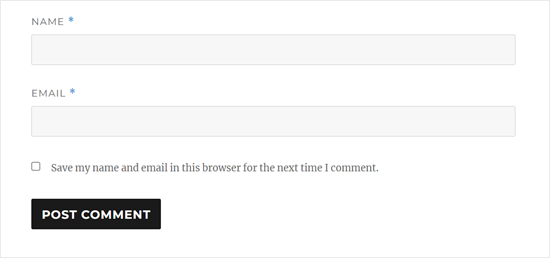
Nous espérons que cet article vous a aidé à apprendre comment retirer le champ de l’URL du site du formulaire de commentaire de WordPress. Vous pouvez également consulter notre guide du débutant sur la façon de modérer les commentaires sur WordPress et nos choix d’experts pour les meilleures extensions de formulaires de contact.
Si vous avez aimé cet article, veuillez alors vous abonner à notre chaîne YouTube pour obtenir des tutoriels vidéo sur WordPress. Vous pouvez également nous trouver sur Twitter et Facebook.





Leslie
I don’t know, do it with the instruction, and some websites don’t work.
WPBeginner Support
If it does not work on a site, it likely means that the theme being used is overriding the default comment form.
Admin
Dipu
Hello, thank you for creating a valuable blog post as it was a question of many about how to remove the website field from the comment form.
I want to know that if allowed the website filed, is it helpful for SEO, because they are nofollow links?
WPBeginner Support
It should not be a major factor in your site’s SEO with either choice.
Admin
Tal
Thanks the php code works great!
WPBeginner Support
Glad it was able to help you!
Admin
osama
well done, and thank you for your great work
WPBeginner Support
You’re welcome, glad you found our guide helpful!
Admin
Giri
Thank You.
I have updated, and the field has been removed.
WPBeginner Support
Glad our guide was able to help!
Admin
Anna Mildwater
Hi, this didn’t work for me (adding the code in the functions.php file) to remove the url field. I’m using a child theme for Astra, so i added it to the functions.php for that. Is that correct?
WPBeginner Support
Adding it to your child theme’s functions.php is the correct thing to do. If it didn’t remove it for you, the theme you are using may have its own method for displaying the field where you would want to check with the support for the child theme you are using and they should be able to assist!
Admin
Andres Berejnoi
Thank you for this tutorial. I have been looking for a way to remove that field for a while. It makes the comment section look more crowde, and it is just an extra step for a legitimate commenter. However, is it possible that my site will become slower if I install these kinds of plugins to solve each problem?
So far, I have not noticed the difference, but I have installed only maybe 5 besides the ones that come by default with the theme.
WPBeginner Support
It would depend on the plugin for how it would affect your site’s speed, for our opinion on plugins and how they affect your site you would want to take a look at our article below:
https://wpbeginner.com/opinion/how-many-wordpress-plugins-should-you-install-on-your-site/
Admin
Obaid
What I do is manually approve comments. Might be exhaustive for a large website, but it’s useful for beginners.
WPBeginner Support
Thanks for sharing what works for you
Admin
Arthur Morehead
The plugins have not been updated in 5 years so I’ll just use the code to remove the URL field. I am using Generate Press (child) theme and not sure if I place it before or after the ?>
Laurens
Excellent! I updated the functions file and that now hopefully gets rid of all the spammy comments on my site.
WPBeginner Support
Hopefully, it at least reduces the amount of spam
Admin
Dan
This still works in 2021.
Thanks for the code. That was easy! Glad to be rid of the website URL field for the comments.
WPBeginner Support
Glad our guide was helpful
Admin
Emmeline
Is there any way to block specific URLs from the actual comment content? When I removed the website field and hyperlink ability, it didn’t stop the spammers from just typing their website at the bottom of their comment. The default “disallowed comment keys” feature matches inside words and not just the entire URL, so I can’t block them that way either (they aren’t using distinct keywords). And of course they use a different email address every time, even though I can tell it’s the same person/group. Right now I’m deleting their comments manually, but it’s very annoying because there are so many. Any advice?
WPBeginner Support
For preventing comment spam, you would want to take a look at the recommendations in our guide below:
https://www.wpbeginner.com/beginners-guide/vital-tips-and-tools-to-combat-comment-spam-in-wordpress/
Admin
Seth
Very helpful. Couldn’t leave without saying thank you
WPBeginner Support
Glad our guide was helpful
Admin
Huzaifa Farrukh
First of all, thanks for always sharing useful tutorials like this.❤️
Secondly, I think I probably never had spend my more time on comment section instead of the article itself…
Quite a conversation going on between Syed and “commenters”
WPBeginner Support
Glad you like our tutorials and there likely is some spam that got by in the comment section if that is what you are talking about. Not everyone is perfect in terms of moderating comments.
Admin
Sharon
Thank you for this post among your other informative posts. This was very helpful. I have been receiving spam comments with website links to other websites. It didn’t help that WordPress has default “website” field for those leaving a comment. This helps. Thanks again for writing this article.
WPBeginner Support
You’re welcome, glad our guide was helpful
Admin
José Vicente Santos Aguilar
Finally I founded code that works. Thanks
WPBeginner Support
You’re welcome
Admin
mohit nagar
hello sir,
i use your tutorial to remove website option from comment.
i copy and paste the code in my functions.php but it only website field location change.
WPBeginner Support
You may want to check with your specific theme’s support to see if they could be overriding something on their end.
Admin
Sameer
Thank you Sir it’s very helpful plugin & information As well as
WPBeginner Support
You’re welcome
Admin
malika
Very informative,i liked…….
WPBeginner Support
Glad you liked our article
Admin
James Emmanuel
Thanks for this article, it was helpful… too much spams while comment section of our site was with link. we actually switched to disqus, but disqus java was too much and had some impart on site speed. with your gauide, we are again back to normal.
WPBeginner Support
Glad our guide was helpful
Admin
md somon
Very helpful post, thank you so mutch
WPBeginner Support
You’re welcome, glad our post was helpful
Admin
Rui Nogueira
Yes but is there any way to automatically erase comments that have links ? ( either bots or human typed )
WPBeginner Support
We do not have a recommended method at the moment sadly.
Admin
Dana
Thank you very much!
WPBeginner Support
You’re welcome
Admin
Will Wilson
Is it okay to delete the plugin afterward, or will the website option pop up again in the comment form?
WPBeginner Support
You would need to keep the plugin for it to keep hiding the fields
Admin
Olidur Rahman
Really very helpful thank you!
WPBeginner Support
You’re welcome, glad you found our guide helpful
Admin
hadil
thank you very nice website article
WPBeginner Support
You’re welcome, glad you like our content
Admin
pawan
Your articles always helpful for me,
All content on the website really very helpful
Thanks a lot for sharing such a helpful information
WPBeginner Support
Glad our article was helpful
Admin
Vara Prasad
Hey big fan for wpbeginner website and your code works perfectly for my disktop& mobile website can plz tell my how to remove Website URL Field from Amp pages and post please
WPBeginner Support
This code should work for the url field for comments on those pages as well
Admin
VARA PRASAD
i used code from wpbeginner website which works perfectly for the normal site but Amp pages showing Website URL field i am using newspaper theme
WPBeginner Support
You may want to reach out to your theme’s support to see if they have styling set up that could be overriding the code here
arun mishra
Great articles. i love reading this. Thnx
WPBeginner Support
Glad you enjoy our articles
Admin
JTCAD
Very detailed article. there is more in comments rather than article even.
WPBeginner Support
Glad you found our article helpful
Admin
Miracle Darlington
Well detailed article.. Learnt alot more from comments than the article itself tho.
George Conklin
I came to your website on purpose looking for a way to remove the Website/URL field on comments forms when I cannot use the functions.php method, so obviously I was looking for a plugin to do that. There doesn’t seem to be an up-to-date and reliable plugin that does this unless its baked into the functionality of another plugin. It might be a great idea to update this post just for that purpose – a working plugin
Iqbal Hussain
How to edit “Your email address will not be published. Required fields are marked *” in wordpress comment form?
Tia Mcintosh
Hey i downloaded and activated both and neither did anything to the comments box. I am just trying to get ride of the option for the comment author to put their website in.
Vishal
Hey there everyone, my theme is Twenty-Seventeen and I was able to remove the “Website URL” field from the Comment Section by just adding this single line code to “Additional CSS” section while customizing it through Appearance>Customize. The code is:
.comment-form-url {display:none;}
This might help or give you some idea I hope
WPBeginner Support
Hi Vishal,
It does not remove the comment form url field, it just hides it. Spamming bots will still be able to see and fill it.
Admin
obed
uncheck the ‘required email and website’ options in settings -> discussion on the dashboard
add the following code to your custom css
#respond .comment-form-email, #respond .comment-form-url {
display: none;
}
bill
Thank you, this has worked a bit…
Naeem Hussain
Dear is there any other way to disable website field from my ComputerPakistan Website. Actually I do not want to add any more plugin in my site.
Pravin Singh
Great article and good information. However, both the plugins mentioned have not been updated for many years and could have compatibility issues with latest versions of WordPress.
Is there an alternative plugin to disable these URLs? If yes, could you kindly update the article as it would be really useful
WPBeginner Support
If you are comfortable adding code to WordPress, then you can try this code in a site-specific plugin or your theme’s functions.php file:
functionwpb_disable_comment_url($fields){unset($fields['url']);return$fields;}add_filter('comment_form_default_fields','wpb_disable_comment_url');1-click Use in WordPress
Admin
IMRAN KHAN
I have added this code in my themes functions.php and it worked but please can you tell me how to rearrange comments section options.My website shows comments option before name and email but i want to show name and email first and then comment option.
Jazib
Hi guys
I like the article but i have concern here that plugins that you have recommended are two years old and unmaintained. Should i install it or not?
Currently i am using No Captcha service from Google via a plugin.
yellowans
hello guys
very interesting topic helped me a lot. here is my issue I deactivacted name, email and url, from my comments. now my comment section is just that comments, nothing else shows.
however the comment for still shows a space for name email and url, the url box I canceled and is not displaying anymore thanks to a plugin,
my question, which plugin (not really a fan of css) can I use to rid of name and mail on the comment entry form thank you and regards
website theme twenty thriteen
Farhan Shah
I had used a plugin “stop spam comments” for stopping spam comments. but after few week felt that I have reduced website hit on my website. my question is that comments has been stopped but why reduced website hits?
Please tell me should I remove this “Stop Spam Comments” plugin and install this plugin “Disable / Hide Comment URL”?
regards
Ciprian C.
Why not just CSS?
p.comment-form-url {height: 0 !important;overflow: hidden !important;}
not the best solution but it works for me.
WPBeginner Support
It will only make the URL field invisible, spam bots will still be able to use the URL field so it doesn’t serve the purpose.
Admin
Chris Mayell
I can corroborate that CSS changes will not suffice.
I was hoping that a simple display:none trick might work. But the messages keep coming.
I’m going to install the plugin you mentioned now.
Thanks to the author for the good suggestion & helpful article.
hassan Gul
thanx.it’s realy help me out.
Colin Crawford
Perhaps the major search engines should look into this as well. These backlinks are getting out of hand, just like when we added keywords to the meta keywords tag. That was abused and now these backlinks are getting abused.
I use a plugin called Disable Comments throughout some of my websites so no one can leave any. So far it has worked but the other websites receive on a daily basis quite a number. Reading through them, there is many adverts with lots of links, people saying how insightful your website is. For one I do not or have ever heard anyone say insightful so straight into the Spam bin.
I don’t think the amount of backlinks should influence your rankings as they can be too easy to get. I went after a web design job and the owner wanted to do some Off page SEO and wanted the successful applicant to be able to get at least 2000 backlinks for that website. Well I didn’t get the job and glad, probably spend the day leaving insightful comments on other peoples websites.
Editorial Staff
Hey Colin,
Comments definitely encourage conversations like this one here. But yes, spammers are ruining it for the webmasters. Getting rid of the link feature has definitely helped reduce spam comments on the site.
Admin
Damien
Any way to remove the comment url from comments when using Jetpack?
Editorial Staff
If the above plugin doesn’t work, then you would have to dissect the Jetpack code (that’s the only other alternative).
Admin
Jenny
Wondering if you could address a couple of concerns? For the plug-in “Disable / Hide Comment URL”
1. is only compatible to 3.2.1.
2. the last update was 2011-9-2 (really old)
Editorial Staff
If you look at the code of this plugin, it is very simple, and it works. You can take the code and dump it in your functions.php file…
functiondisable_comment_url($fields) {unset($fields['url']);return$fields;}add_filter('comment_form_default_fields','disable_comment_url');1-click Use in WordPress
So in short, no this plugin is compatible with recent versions. The author just didn’t update the plugin because it simply works. Why update when it is not broken?
Admin
Regev
Awesome!
How do I also…
1. Change the default “Your email address will not be published. Required fields are marked *” into a custom text, like you have done.
2. Remove the * from “Name” and “Email”, and change “Name” to “Your Real Name”
Thanks.
Gautam Doddamani
i guess we already had a long conversation about this a long time back…i think since you got rid of livefyre…yea i agree this helps get rid of spam users and keep legit comments comin’! real nice plugins…wil check ’em out!
Cheers,
Gautam
Shalu Sharma
Nice article and I can understand why people want to remove it but can’t you use the right plugins to moderate and control spam? Thanks for the tutorial, if I do decide to then I know where to look for it.
Cliff Beneventi
Thanks for the article. Reducing or eliminating spam is a critical part of comment management. Akismet does a great job for my clients, but uses URL’s to determine if a comment is spam. This plugin would then render Akismet less effectual. Also, the user can simply insert a URL in the comment itself, can they not? Lastly, I thought that the bulk of spam comments were generated by bots, which would still populate the comment field, even in the absence of a URL field.
Zimbrul
What crosses my mind right now is this “being WPBeginner, o e of the solid sites out there providing quality WordPress tutorials and advice, you can afford to not show the author link on your comment form”. In fact this will dicourage many to comment unless they really have something to say.
I only comment on articles that interest me and never said just “oh, great article, I’ll bookmark it, fantastic piece of writing”.
Elliott Richmond
Agreed, if someone is making the effort to comment on an article the least you can do is credit them with a link! After all it’s about the community right? I noticed this on WPB a while ago and it put me right off commenting full stop! Not that I comment for the backlink because it’s a nofollow anyway but because if any other commenters what to check me out they can.
Zimbrul
Yes, this is the idea of the author website field. But, as I said, I do mot comment here at wpbeginner for backlinks or for make myself known. I use WP Beginner website to get answers and to implement new te tehniques on sites I develop.
I only comment to topics I can “technically” comment, that’s it.
Editorial Staff
Elliot, first of all I’m sorry to hear that you have stopped commenting on WPBeginner just because we decided to get rid of the URL field. While your initial intentions weren’t to get backlinks, but your decision to stop commenting after we get rid of the field only emphasize the point.
If you do not think that a community is worth contributing to just because you are not getting a backlink/promotional value, then I don’t think that you value the community enough.
We have had internal communications about establishing a proper registration system for regular users on WPBeginner. This would allow us to unlock certain perks (i.e backlinks to all of your new and previous comments after you hit comment count marker X). But again, I feel odd because I’m offering incentives for users to comment which is favoring quantity over quality.
I will probably have this added as one of the questions in our annual survey for the WPBeginner audience.
Admin
Elliott Richmond
Not “stop commenting” or “stopped commenting” just “put off” ^_^
On the contrary I do value the community and I hope that I do offer value back to the community (albiet in a very small way compared to others) and I find your tone a little insulting to be honest!
I believe that there are other contributors who I would certainly like to find out more about but seeing as you have denied a link back to their site where I can find out about “the community” it kind of defeats the object wouldn’t you agree? Fortunately I do recognised some of the contributors who I do value, Pippin being one of them but, if I’d like to find out about others then I have no chance right?
Editorial Staff
I won’t argue semantics of stop commenting or “commenting full stop”. Nonetheless, I see your point of finding user’s information and following up with them elsewhere. One thing that can be done perhaps is hyperlink all gravatar images with the user’s gravatar profile? Would you say that is a good solution?
Always love hearing user feedback. This is why I will be adding this in the user survey that we are planning on sending out.
-Syed
Editorial Staff
Zimbrul, first of all, I really appreciate you as a user. I have your gravatar memorized because I know you are one of our regular users. This technique is not to discourage users like yourself because you add relevant and useful conversation to the articles like this comment of yours.
It is also one of the reasons why our site automatically approves your comment But you are among the exception. I can personally tell you that this is a big issue specially if you are running a tech related tutorial blog.
But you are among the exception. I can personally tell you that this is a big issue specially if you are running a tech related tutorial blog.
SmashingMagazine has the same thing. They did this long time ago, way before WPBeginner. Reason was the same. I as a user appreciated their decision of getting rid of URLs because then I could engage in meaningful conversations with real people (not those drop by’s who might add controversial comment just to get a backlink and never check back).
-Syed
Admin
Zimbrul
Syed, your kind words means more than a backlink for me, don’t you guys agree? For me the words of appreciation from one of the most respected figures in WordPress community means a lot and as I said I come here not for the backlink but for problem solving most of the time. Sometimes I need advice sometimes I can contribute.